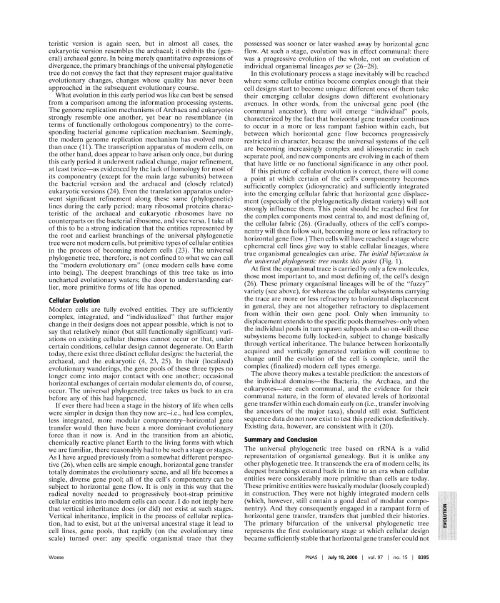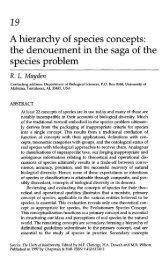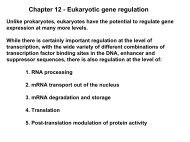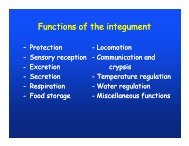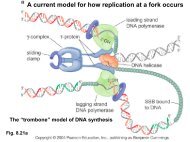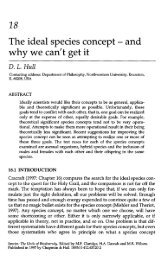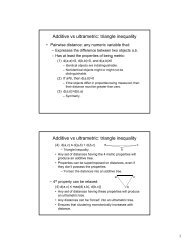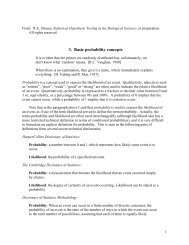Interpreting the universal phylogenetic tree
Interpreting the universal phylogenetic tree
Interpreting the universal phylogenetic tree
You also want an ePaper? Increase the reach of your titles
YUMPU automatically turns print PDFs into web optimized ePapers that Google loves.
teristic version is again seen, but in almost all cases, <strong>the</strong>eukaryotic version resembles <strong>the</strong> archaeal; it exhibits <strong>the</strong> (general)archaeal genre. In being merely quantitative expressions ofdivergence, <strong>the</strong> primary branchings of <strong>the</strong> <strong>universal</strong> <strong>phylogenetic</strong><strong>tree</strong> do not convey <strong>the</strong> fact that <strong>the</strong>y represent major qualitativeevolutionary changes, changes whose quality has never beenapproached in <strong>the</strong> subsequent evolutionary course.What evolution in this early period was like can best be sensedfrom a comparison among <strong>the</strong> information processing systems.The genome replication mechanisms of Archaea and eukaryotesstrongly resemble one ano<strong>the</strong>r, yet bear no resemblance (interms of functionally orthologous componentry) to <strong>the</strong> correspondingbacterial genome replication mechanism. Seemingly,<strong>the</strong> modern genome replication mechanism has evolved morethan once (11). The transcription apparatus of modern cells, on<strong>the</strong> o<strong>the</strong>r hand, does appear to have arisen only once, but duringthis early period it underwent radical change, major refinement,at least twice-as evidenced by <strong>the</strong> lack of homology for most ofits componentry (except for <strong>the</strong> main large subunits) between<strong>the</strong> bacterial version and <strong>the</strong> archaeal and (closely related)eukaryotic versions (24). Even <strong>the</strong> translation apparatus underwentsignificant refinement along <strong>the</strong>se same (<strong>phylogenetic</strong>)lines during <strong>the</strong> early period; many ribosomal proteins characteristicof <strong>the</strong> archaeal and eukaryotic ribosomes have nocounterparts on <strong>the</strong> bacterial ribosome, and vice versa. I take allof this to be a strong indication that <strong>the</strong> entities represented by<strong>the</strong> root and earliest branchings of <strong>the</strong> <strong>universal</strong> <strong>phylogenetic</strong><strong>tree</strong> were not modern cells, but primitive types of cellular entitiesin <strong>the</strong> process of becoming modern cells (23). The <strong>universal</strong><strong>phylogenetic</strong> <strong>tree</strong>, <strong>the</strong>refore, is not confined to what we can call<strong>the</strong> "modern evolutionary era" (once modern cells have comeinto being). The deepest branchings of this <strong>tree</strong> take us intouncharted evolutionary waters; <strong>the</strong> door to understanding earlier,more primitive forms of life has opened.Cellular EvolutionModern cells are fully evolved entities. They are sufficientlycomplex, integrated, and "individualized" that fur<strong>the</strong>r majorchange in <strong>the</strong>ir designs does not appear possible, which is not tosay that relatively minor (but still functionally significant) variationson existing cellular <strong>the</strong>mes cannot occur or that, undercertain conditions, cellular design cannot degenerate. On Earthtoday, <strong>the</strong>re exist three distinct cellular designs: <strong>the</strong> bacterial, <strong>the</strong>archaeal, and <strong>the</strong> eukaryotic (4, 23, 25). In <strong>the</strong>ir (localized)evolutionary wanderings, <strong>the</strong> gene pools of <strong>the</strong>se three types nolonger come into major contact with one ano<strong>the</strong>r; occasionalhorizontal exchanges of certain modular elements do, of course,occur. The <strong>universal</strong> <strong>phylogenetic</strong> <strong>tree</strong> takes us back to an erabefore any of this had happened.If ever <strong>the</strong>re had been a stage in <strong>the</strong> history of life when cellswere simpler in design than <strong>the</strong>y now are-i.e., had less complex,less integrated, more modular componentry-horizontal genetransfer would <strong>the</strong>n have been a more dominant evolutionaryforce than it now is. And in <strong>the</strong> transition from an abiotic,chemically reactive planet Earth to <strong>the</strong> living forms with whichwe are familiar, <strong>the</strong>re reasonably had to be such a stage or stages.As I have argued previously from a somewhat different perspective(26), when cells are simple enough, horizontal gene transfertotally dominates <strong>the</strong> evolutionary scene, and all life becomes asingle, diverse gene pool; all of <strong>the</strong> cell's componentry can besubject to horizontal gene flow. It is only in this way that <strong>the</strong>radical novelty needed to progressively boot-strap primitivecellular entities into modern cells can occur. I do not imply herethat vertical inheritance does (or did) not exist at such stages.Vertical inheritance, implicit in <strong>the</strong> process of cellular replication,had to exist, but at <strong>the</strong> <strong>universal</strong> ancestral stage it lead tocell lines, gene pools, that rapidly (on <strong>the</strong> evolutionary timescale) turned over: any specific organismal trace that <strong>the</strong>ypossessed was sooner or later washed away by horizontal geneflow. At such a stage, evolution was in effect communal: <strong>the</strong>rewas a progressive evolution of <strong>the</strong> whole, not an evolution ofindividual organismal lineages per se (26-28).In this evolutionary process a stage inevitably will be reachedwhere some cellular entities become complex enough that <strong>the</strong>ircell designs start to become unique: different ones of <strong>the</strong>m take<strong>the</strong>ir emerging cellular designs down different evolutionaryavenues. In o<strong>the</strong>r words, from <strong>the</strong> <strong>universal</strong> gene pool (<strong>the</strong>communal ancestor), <strong>the</strong>re will emerge "individual" pools,characterized by <strong>the</strong> fact that horizontal gene transfer continuesto occur in a more or less rampant fashion within each, butbetween which horizontal gene flow becomes progressivelyrestricted in character, because <strong>the</strong> <strong>universal</strong> systems of <strong>the</strong> cellare becoming increasingly complex and idiosyncratic in eachseparate pool, and new components are evolving in each of <strong>the</strong>mthat have little or no functional significance in any o<strong>the</strong>r pool.If this picture of cellular evolution is correct, <strong>the</strong>re will comea point at which certain of <strong>the</strong> cell's componentry becomessufficiently complex (idiosyncratic) and sufficiently integratedinto <strong>the</strong> emerging cellular fabric that horizontal gene displacement(especially of <strong>the</strong> <strong>phylogenetic</strong>ally distant variety) will notstrongly influence <strong>the</strong>m. This point should be reached first for<strong>the</strong> complex components most central to, and most defining of,<strong>the</strong> cellular fabric (26). (Gradually, o<strong>the</strong>rs of <strong>the</strong> cell's componentrywill <strong>the</strong>n follow suit, becoming more or less refractory tohorizontal gene flow.) Then cells will have reached a stage whereephemeral cell lines give way to stable cellular lineages, wheretrue organismal genealogies can arise. The initial bifurcation in<strong>the</strong> <strong>universal</strong> <strong>phylogenetic</strong> <strong>tree</strong> marks this point (Fig. 1).At first <strong>the</strong> organismal trace is carried by only a few molecules,those most important to, and most defining of, <strong>the</strong> cell's design(26). These primary organislnal lineages will be of <strong>the</strong> "fuzzy"variety (see above), for whereas <strong>the</strong> cellular subsystems carrying<strong>the</strong> trace are more or less refractory to horizontal displacementin general, <strong>the</strong>y are not altoge<strong>the</strong>r refractory to displacementfrom within <strong>the</strong>ir own gene pool. Only when immunity todisplacement extends to <strong>the</strong> specific pools <strong>the</strong>mselves-onlywhen<strong>the</strong> individual pools in turn spawn subpools and so on-will <strong>the</strong>sesubsystems become fully locked-in, subject to change basicallythrough vertical inheritance. The balance between horizontallyacquired and vertically generated variation will continue tochange until <strong>the</strong> evolution of <strong>the</strong> cell is complete, until <strong>the</strong>complex (finalized) modern cell types emerge.The above <strong>the</strong>ory makes a testable prediction: <strong>the</strong> ancestors of<strong>the</strong> individual domains-<strong>the</strong> Bacteria, <strong>the</strong> Archaea, and <strong>the</strong>eukaryotes-are each communal, and <strong>the</strong> evidence for <strong>the</strong>ircommunal nature, in <strong>the</strong> form of elevated levels of horizontalgene transfer within each domain early on (i.e., transfer involving<strong>the</strong> ancestors of <strong>the</strong> major taxa), should still exist. Sufficientsequence data do not now exist to test this prediction definitively.Existing data, however, are consistent with it (20).Summary and ConclusionThe <strong>universal</strong> <strong>phylogenetic</strong> <strong>tree</strong> based on rRNA is a validrepresentation of organismal genealogy. But it is unlike anyo<strong>the</strong>r <strong>phylogenetic</strong> <strong>tree</strong>. It transcends <strong>the</strong> era of modern cells; itsdeepest branchings extend back in time to an era when cellularentities were considerably more primitive than cells are today.These primitive entities were basically modular (loosely coupled)in construction. They were not highly integrated modern cells(which, however, still contain a good deal of modular componentry).And <strong>the</strong>y consequently engaged in a rampant form ofhorizontal gene transfer, transfers that jumbled <strong>the</strong>ir histories.The primary bifurcation of <strong>the</strong> <strong>universal</strong> <strong>phylogenetic</strong> <strong>tree</strong>represents <strong>the</strong> first evolutionary stage at which cellular designbecame sufficiently stable that horizontal gene transfer could notWoesePNAS I July 18, 2000 I vol. 97 I no. 15 I 8395


